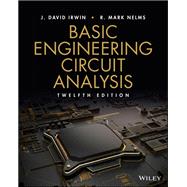Basic Engineering Circuit Analysis has long been regarded as the most dependable textbook for computer and electrical engineering majors. In this new edition, Irwin and Nelms continue to develop the most complete set of pedagogical tools available and provide the highest level of support for students entering into this complex subject. Irwin and Nelms trademark student-centered learning design focuses on helping students complete the connection between theory and practice. Key concepts are explained clearly and illustrated by detailed, worked examples. These are then followed by Learning Assessments, which allow students to work similar problems and check their results against the answers provided.









